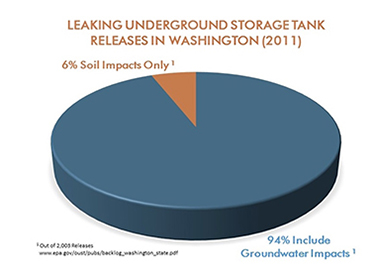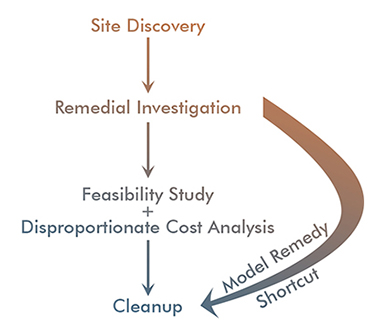|
Subscribe / Renew |
|
|
Contact Us |
|
| ► Subscribe to our Free Weekly Newsletter | |
| home | Welcome, sign in or click here to subscribe. | login |
Environment
| |
 |
September 24, 2015
New Ecology cleanup guidance: mirage or oasis?
Aspect Consulting

Germiat
|
Earlier this month, the state Department of Ecology’s “model remedies” guidance for sites with petroleum-contaminated soil went into effect, and its vision is compelling.
Less time and less money to clean up a contaminated property? A fast-track process to getting regulatory thumbs up on site closure?
Using model remedies has some very good, red-tape-cutting intentions. It does this by prescribing a preapproved regulatory pathway that you can take if your site meets certain criteria.
On the face of it, this is great news.
However, because this first set of model remedies applies only to a very limited number of sites and establishes at least one troublesome policy precedent, this vision looks more mirage than oasis at this point. As such, it’s best to look at this as merely a first step to speeding up Ecology’s backlog of site reviews. A significant expansion of the program is needed to achieve the vision.
The vision
The provision for model remedies has been a part of the Model Toxics Control Act (MTCA) since 2001, but it has seen little use. In 2013, with a backlog of contaminated sites awaiting review, the state Legislature passed Senate Bill 5296 to open up new paths to permitting compliance and, hopefully, a faster route for restoring contaminated properties to beneficial reuse.
Ecology’s approach is akin to the U.S. Environmental Protection Agency’s presumptive remedies concept, which is commonly applied at certain sites (especially landfills) with good results.
In theory, the benefits of model remedies could be substantial.
In the MTCA cleanup process — encompassing site evaluation through remedy selection — the feasibility study, including the disproportionate cost analysis requirement, can be a substantial effort. With the model remedies shortcut, the feasibility study step can be bypassed, thus saving time and money. In addition, Ecology may waive its costs for reviewing independent cleanups using model remedies, which can provide modest cost savings.
Circumventing these costs and time looks to be a no-brainer for a site owner or redeveloper eager to put their contaminated property to productive use.
The reality
However, when homing in on the key measure of the model remedies process — the “criteria” — it’s clear that this guidance is still in its infancy. The current model remedies are narrowly focused on petroleum-contaminated sites where impacts are to soil only and there are no detectable contaminant concentrations in groundwater. To look at just one example of how small this is, only 6 percent of leaking underground storage tank sites in Washington state fall into this category (based on a 2011 EPA study).
In addition, despite Ecology presenting seven model remedies for such sites, there really are only two: dig it all to meet cleanup levels, or dig all that is accessible and restrict land use (i.e., put an environmental covenant on the property to address what you can’t remove).
Full removal is often the most costly option available for cleaning up a petroleum-contaminated site. Therefore, the price tag of digging out all the soil may cancel out any time and cost savings coming your way by avoiding some reporting requirements through the model remedies process.
Further limiting the applicability of model remedies is a provision that excludes sites where non-petroleum compounds have been detected, even if they are below applicable cleanup criteria. Introducing “non-detect” instead of a cleanup level as a new regulatory criterion is a particularly concerning policy precedent.
The good news
The model remedies guidance does provide some useful tools. It identifies a generic petroleum-cleanup-level protective of the direct contact pathway. Previously, this was only conducted on a site-specific basis using expensive laboratory analysis. For example, at petroleum sites with no groundwater impacts, this allows a much less restrictive alternative to the standard MTCA cleanup level.
Where the model remedies are perhaps most helpful is in avoiding a disproportionate cost analysis to justify environmental covenants on properties where contaminated soil is inaccessible due to constraints such as buildings or utilities.
These approaches are good news, not just for the limited number of sites addressed by the current guidance, but potentially for other sites to which these tools may also apply.
Furthermore, Ecology is welcoming feedback on expanding the process. Just before releasing the current soil-only guidance this September, the agency held a listening session that included discussion of model remedies for groundwater contamination (i.e., the cleanup priority for most contaminated sites).
Good intentions, limited use
The current set of model remedies can provide substantive schedule and savings value for those sites that have only petroleum contamination, pose little risk to the property or human health, and for which the owner requires a fast cleanup with no long-term stewardship obligations.
However, for the vast majority of cleanup sites that do not meet that narrow profile, the model remedies break little if any new ground. They may prove to have negative consequences for the regulated community if the conservative criteria for identifying what qualifies as a model remedy are adopted as a basis for remedy decisions at other sites. In particular, the model remedies guidance selects removal over containment capping even when the costs are disproportionate, and the overall environmental benefit is negligible or even negative (for example, through generating greenhouse gases).
How Ecology site managers bring the model remedies provisions into play on sites not applying model remedies remains to be seen.
In light of the current and future model remedies being developed, it is critical that owners of contaminated properties understand the proper context for their use, and equally understand the potential advantages of going through the full MTCA remedy selection process to arrive at the most protective and practicable cleanup remedy tailored to each site.
Steve Germiat is a principal hydrogeologist at Aspect Consulting with 26 years of experience in the MTCA cleanup process — from remedial investigation and feasibility study through remedial design and implementation.
Other Stories:
- LID development training is a game changer here
- Survey: Shannon & Wilson
- Survey: Ridolfi
- Survey: Climate Solutions
- Survey: O’Brien & Co.
- Survey: Cascadia Consulting Group
- Survey: Golder Associates
- How deep green buildings can educate kids
- Here’s how to improve environmental health and safety
- Kirkland taps county’s purple pipes for recycled water
- Drought heats up battle over water rights
- Designing infrastructure to combat climate change
- Building green? Don’t forget green financing
- Survey: Innovex Environmental Management




